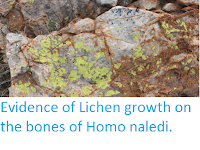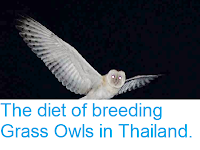The Dinaledi Chamber in the Rising Star Cave forms part of the Maropeng Cradle of Humankind complex of caves in Gauteng State, to the northwest of Johannesburg, South Africa. Like many other caves in the system it was visited from time-to-time by cavers for several decades, but was not formally investigated by scientists until September 2013, when the skeletons of a previously unknown Hominin species were discovered there, and named Homo naledi. A number of Bird bones were discovered at the same time as the Hominin remains, but have not previously been formally identified or described.
In a paper published in the South African Journal of Science on 27 November 2018, Ashley Kruger and Shaw Badenhorst of the Evolutionary Studies Institute at the University of the Witwatersrand describe the Bird remains found inside the Dinaledi Chamber in 2013 as the remains of a Barn Owl, Tyto alba.
Barn Owls are one of the most widely distributed Birds on Earth, being found in almost all terrestrial environments, with the exception of Antarctica, the central Sahara, and some remote islands. They nest in enclosed spaces, including hollow trees, Human-built structures (such as barns) and caves, a habitat they are particularly known to favour in parts of South Africa where caves are often the best cover available in wide areas of open grassland.
The Dinaledi Chamber material comprises a largely complete tarsometatarsus, the mid-distal shaft and part of the distal condyle of a left tibiotarsus, the distal, mid and proximal shaft of a right radius, and proximal, mid and distal shaft, plus a small portion of the distal articulation of a right ulna. These were found on a raised platform within the Dinaledi Chamber, alongside some other bone material, though as the Owl bone fragments show no signs of re-mineralisation, they are assumed to be much younger than those of the Homo naledi specimens found within the cave, and their placement is therefore assumed to be due to the activities of modern cavers.
Barn Owls are one of the most widely distributed Birds on Earth, being found in almost all terrestrial environments, with the exception of Antarctica, the central Sahara, and some remote islands. They nest in enclosed spaces, including hollow trees, Human-built structures (such as barns) and caves, a habitat they are particularly known to favour in parts of South Africa where caves are often the best cover available in wide areas of open grassland.
The Dinaledi Chamber material comprises a largely complete tarsometatarsus, the mid-distal shaft and part of the distal condyle of a left tibiotarsus, the distal, mid and proximal shaft of a right radius, and proximal, mid and distal shaft, plus a small portion of the distal articulation of a right ulna. These were found on a raised platform within the Dinaledi Chamber, alongside some other bone material, though as the Owl bone fragments show no signs of re-mineralisation, they are assumed to be much younger than those of the Homo naledi specimens found within the cave, and their placement is therefore assumed to be due to the activities of modern cavers.
(a) Specimen U.W. 101 40C, a left tibiotarsus fragment of Tyto alba, with the mid-distal shaft present, and part of the distal condyle; (b) specimen U.W. 101 40B, a right radius fragment of Tyto alba, consisting of the distal, mid and proximal shaft, with the distal styloid process absent; (c) specimens U.W. 101 965 and 822, a right ulna fragment of Tyto alba, consisting of the proximal, mid and distal shaft, with a small portion of the distal articulation present. Kruger & Badenhorst (2018).
Kruger and Badenhorst suggest several ways in which the bones might have got into the Dinaledi Chamber. Firstly, they suggest the Owl might have flown into the cave system and got lost, eventually perishing in the chamber. Secondly, they suggest that the Owl might have fallen down a narrow shute close to the chamber, although this would not put the remains actually in the chamber (not a major problem, as the bones are presumed to have been moved onto the platform by Human activity). Thirdly, the bones might have been carried into the cave system from elsewhere by a modern caver, though why anybody should do this is unclear. Fourthly, it is possible that there was once a second entrance to the chamber, which has since been sealed, and that, therefore, both the Owl and the Hominins were actually entering a cave much closer to the surface, something which has been suggested by palaeontologist Francis Thackeray, though no evidence for such a second entrance has been found to date.
See also...
See also...
Follow Sciency Thoughts on Facebook.







